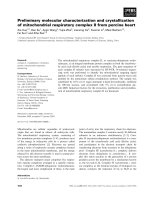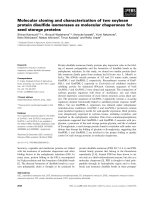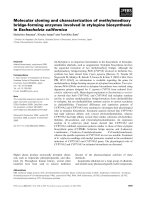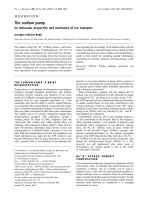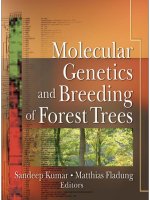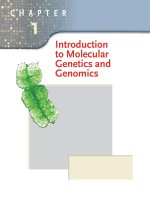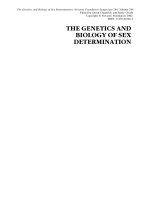kumar - molecular genetics and breeding of forest trees (haworth, 2004)
Bạn đang xem bản rút gọn của tài liệu. Xem và tải ngay bản đầy đủ của tài liệu tại đây (9.91 MB, 468 trang )
Sandeep Kumar, PhD
Matthias Fladung, PhD
Editors
Molecular Genetics
and Breeding of Forest Trees
Pre-publication
REVIEWS,
COMMENTARIES,
EVALUATIONS . . .
“M
olecular tools are indispensable
for the development of sus-
tainable strategies to utilize and con-
serve forest genetic resources. Marker
technologies and the availability of
transformation tools allow new in
-
sights into the genetic basis of physio
-
logical processes and genome organi
-
zation of trees. Innovative breeding
methods based on marker-assisted se
-
lection and genetic transformation have
been developed and will gain further
importance in forest genetics and tree
breeding. In view of a rapidly increas
-
ing number of different marker types
and transformation approaches, it is not
easy to define what is ‘state-of-the-art’
in this field for forest trees. This gap is
filled by Molecular Genetics and Breeding
of Forest Trees, which provides concise
information on the most recent and
important developments in molecular
forest genetics. Kumar and Fladung
successfully keep the balance between
instructive reviews on key aspects in
molecular genetics such as functional
genomics, ESTs, and SSRs, and the pro
-
found case studies addressing temper
-
ate and tropical trees.”
Prof. Dr. Reiner Finkeldey
Chair of Forest Genetics
and Forest Tree Breeding,
Georg-August-University Göttingen,
Germany
More pre-publication
REVIEWS, COMMENTARIES, EVALUATIONS . . .
“M
olecular Genetics and Breeding of
Forest Trees makes it clear that
the science is moving ahead impres
-
sively. The editors havecarefully crafted
it to include the major scientific thrusts
in forest biotechnology. These span gen
-
omic maps and markers as supple
-
ments to traditional breeding through
to novel means for altering the charac
-
teristics of wood and tree production,
with the goal of enabling new kinds of
highly domesticated, biosafe planta
-
tions to be employed.
Highlights of the book include a de
-
scription of the EST databases of Gene-
sis Research and Development Corpo-
ration, Ltd., in New Zealand; an excel-
lent review of the state of knowledge of
lignin biosynthetic genes in plants, par-
ticularly with regard to prospects for
genetic engineering; and a comprehen-
sive review of attempts to induce flow-
ering and impart sterility in trees. A
number of chapters discuss the consid-
erable progress in the use of genomics
tools to understand fundamental as-
pects of tree biology, including high
quality chapters on pine proteomics,
fungal and plant changes in gene ex
-
pression during mycorrhizal associa
-
tion, use of microsatellite markers for
population and systematic biology, and
the integration of genetic maps in pop
-
lar for analysis of disease resistance.
With a focus on science, this book
proves that the research progress on for
-
est biotechnology is impressive; oppor
-
tunities abound for much further scien
-
tific advance; field verifications of eco
-
nomic value and ecological effect are
badly needed; and that the commercial
and social landscape regarding public
and market acceptance is complex.”
Steven H. Strauss
Professor, Department of Forest Science,
Oregon State University
“T
he knowledge and techniques of
molecular biology are of great
assistance in addressing diverse aspects
of forest genomics. In the past decade
there has been a great surge of knowl
-
edge about molecular aspects of the tree
genome and its application for improv
-
ing the quality and productivity of for
-
ests, which has been spread through a
diverse array of journals and periodi
-
cals in need of consolidation for educa
-
tional and reference material. Molecular
Genetics and Breeding of Forest Trees is a
wonderful accomplishment in this di
-
rection. The book provides a wealth of
classified information dealing with tree
genome analysis at the molecular level
with regard to genetic diversity, quanti-
tative trait loci, ectomycorrhizal symbi-
osis, physiobiochemical pathways of
wood, lignin formation, and develop-
ment of transgenesis and high-density
linkage maps for forest trees. The re-
nowned contributors elegantly crafted
each chapter, suited alike to both class-
room texts for graduate students and
reference material for researchers. The
language and style is simple and lucid
with liberal use of illustrations. This
book should be on the shelf of school
and university libraries for inquisitive
students and enlightened researchers.”
Dr. Shamim Akhtar Ansari
Scientist “E,”
Genetics and Plant Propagation Division,
Tropical Forest Research Institute,
Jabalpur, India
NOTES FOR PROFESSIONAL LIBRARIANS
AND LIBRARY USERS
This is an original book title published by Food Products Press®, an
imprint of The Haworth Press, Inc. Unless otherwise noted in specific
chapters with attribution, materials in this book have not been previ-
ously published elsewhere in any format or language.
CONSERVATION AND PRESERVATION NOTES
All books published by The Haworth Press, Inc. and its imprints are
printed on certified pH neutral, acid free book grade paper. This paper
meets the minimum requirements of American National Standard for
Information Sciences-Permanence of Paper for Printed Material,
ANSI Z39.48-1984.
Molecular Genetics
and Breeding of Forest Trees
FOOD PRODUCTS PRESS
®
Crop Science
Amarjit S. Basra, PhD
Senior Editor
Mineral Nutrition of Crops: Fundamental Mechanisms and Implications by Zdenko Rengel
Conservation Tillage in U.S. Agriculture: Environmental, Economic, and Policy Issues
by Noel D. Uri
Cotton Fibers: Developmental Biology, Quality Improvement, and Textile Processing
edited by Amarjit S. Basra
Heterosis and Hybrid Seed Production in Agronomic Crops edited by Amarjit S. Basra
Intensive Cropping: Efficient Use of Water, Nutrients, and Tillage by S. S. Prihar, P. R. Gajri,
D. K. Benbi, and V. K. Arora
Physiological Bases for Maize Improvement edited by María E. Otegui and Gustavo A. Slafer
Plant Growth Regulators in Agriculture and Horticulture: Their Role and Commercial Uses
edited by Amarjit S. Basra
Crop Responses and Adaptations to Temperature Stress edited by Amarjit S. Basra
Plant Viruses As Molecular Pathogens by Jawaid A. Khan and Jeanne Dijkstra
In Vitro Plant Breeding by Acram Taji, Prakash P. Kumar, and Prakash Lakshmanan
Crop Improvement: Challenges in the Twenty-First Century edited by Manjit S. Kang
Barley Science: Recent Advances from Molecular Biology to Agronomy of Yield and Quality
edited by Gustavo A. Slafer, José Luis Molina-Cano, Roxana Savin, José Luis Araus,
and Ignacio Romagosa
Tillage for Sustainable Cropping by P. R. Gajri, V. K. Arora, and S. S. Prihar
Bacterial Disease Resistance in Plants: Molecular Biology and Biotechnological Applications
by P. Vidhyasekaran
Handbook of Formulas and Software for Plant Geneticists and Breeders edited by Manjit
S. Kang
Postharvest Oxidative Stress in Horticultural Crops edited by D. M. Hodges
Encyclopedic Dictionary of Plant Breeding and Related Subjects by Rolf H. G. Schlegel
Handbook of Processes and Modeling in the Soil-Plant System edited by D. K. Benbi
and R. Nieder
The Lowland Maya Area: Three Millennia at the Human-Wildland Interface edited
by A. Gómez-Pompa, M. F. Allen, S. Fedick, and J. J. Jiménez-Osornio
Biodiversity and Pest Management in Agroecosystems, Second Edition by Miguel A. Altieri
and Clara I. Nicholls
Plant-Derived Antimycotics: Current Trends and Future Prospects edited by Mahendra Rai
and Donatella Mares
Concise Encyclopedia of Temperate Tree Fruit edited by Tara Auxt Baugher and Suman Singha
Landscape Agroecology by Paul A Wojkowski
Concise Encylcopedia of Plant Pathology by P. Vidhyaskdaran
Molecular Genetics and Breeding of Forest Trees edited by Sandeep Kumar and Matthias
Fladung
Testing of Genetically Modified Organisms in Foods edited by Farid E. Ahmed
Molecular Genetics
and Breeding of Forest Trees
Sandeep Kumar, PhD
Matthias Fladung, PhD
Editors
Food Products Press®
An Imprint of The Haworth Press, Inc.
New York • London • Oxford
Published by
Food Products Press®, an imprint of The Haworth Press, Inc., 10 Alice Street, Binghamton, NY
13904-1580.
© 2004 by The Haworth Press, Inc. All rights reserved. No part of this work may be reproduced or
utilized in any form or by any means, electronic or mechanical, including photocopying, microfilm,
and recording, or by any information storage and retrieval system, without permission in writing
from the publisher. Printed in the United States of America.
Cover design by Marylouise E. Doyle.
Library of Congress Cataloging-in-Publication Data
Molecular genetics and breeding of forest trees / Sandeep Kumar, Matthias Fladung, editors.
p. cm.
Includes bibliographical references (p. ) and index.
ISBN 1-56022-958-6 (hardcover : alk. paper) — ISBN 1-56022-959-4 (softcover : alk. paper)
1. Trees—Breeding. 2. Trees—Molecular genetics. 3. Forest genetics. I. Kumar, Sandeep.
II. Fladung, Matthias.
SD399.5.M66 2003
634.9'56—dc21
2002156648
CONTENTS
About the Editors xiii
Contributors xv
Preface xix
PART I: FOREST TREE FUNCTIONAL GENOMICS
Chapter 1. Functional Genomics in Forest Trees 3
Alison M. Morse
Janice E. K. Cooke
John M. Davis
Introduction 3
The Functional Genomics Tool Kit—Transcript Discovery
and Profiling 4
Functional Genomics in Action 10
En Route to Functional Genomics in Forest Trees 12
Conclusions 15
Chapter 2. Expressed Sequence Tag Databases
from Forestry Tree Species 19
Timothy J. Strabala
Introduction 19
Forestry Tree EST Databases 21
The Genesis Pine and Eucalyptus EST Projects 26
Special Purpose Libraries 41
Conclusion 47
Chapter 3. Proteomics for Genetic and Physiological
Studies in Forest Trees: Application in Maritime Pine 53
Christophe Plomion Jean-Marc Gion
Nasser Bahrman Céline Lalanne
Paulo Costa Delphine Madur
Christian Dubos Cédric Pionneau
Jean-Marc Frigerio Sophie Gerber
Introduction 53
Characterization of the Pine Proteome 55
Genetic Variability of Qualitative and Quantitative
Protein Variants 62
Variability of Proteome Expression in Physiological Studies 68
Conclusion 73
Chapter 4. Exploring the Transcriptome
of the Ectomycorrhizal Symbiosis 81
Francis Martin Annegret Kohler
Sébastien Duplessis Denis Tagu
Introduction 81
The Ectomycorrhizal Symbiosis 82
The Anatomy and Development of Ectomycorrhiza 83
The Morphogenesis of Ectomycorrhiza 86
Alteration in Gene Expression in Ectomycorrhiza 87
The Transcriptome of Ectomycorrhizal Symbioses 90
Outlook 102
PART II: MOLECULAR BIOLOGY OF WOOD
FORMATION
Chapter 5. Genomics of Wood Formation 113
Jae-Heung Ko Sunchung Park
Jaemo Yang Kyung-Hwan Han
Sookyung Oh
Introduction 113
Wood Biosynthesis 114
Regulation of Wood Formation 120
Arabidopsis As a Model for the Study of Wood
Formation 123
Genomics Approach to Wood Formation 124
The Outlook 132
Chapter 6. Molecular Genetics of Cellulose Biosynthesis
in Trees 141
Chandrashekhar P. Joshi
Introduction 141
Cellulose Heterogeneity in Trees 142
Cellulose Production Under Mechanical Stress 143
The Site of Cellulose Biosynthesis 144
Current Knowledge of the General Process of Cellulose
Synthesis in Plants 145
Identification of C
esA Genes in Plants 146
Isolation of New C
esA and CSLD Genes 151
Future Perspectives 162
Chapter 7. Tuning Lignin Metabolism Through Genetic
Engineering in Trees 167
Lise Jouanin
Thomas Goujon
Introduction 167
Genetic Modification of PAL and C4H 171
Genetic Modification of 4CL 174
Genetic Modification of C3H 174
Genetic Modification of CCoAOMT 175
Genetic Modification of CCR 175
Genetic Modification of F5H 176
Genetic Modification of COMT 177
Genetic Modification of CAD 179
Genetic Modification of Peroxidases and Laccases 181
Genetic Modification of Transcription Factors 182
Outlook 183
Chapter 8. In Vitro Systems for the Study of Wood
Formation 193
Mathew A. Leitch
Gerd Bossinger
Introduction 193
Cambial Activity 194
Wood Formation 194
The Formation of Tracheary Elements 195
Heartwood Formation (Tylosis and Pit Aspiration) 196
In Vitro Wood Formation Systems 199
Future Perspectives 203
PART III: FOREST TREE TRANSGENESIS
Chapter 9. Genetic Modification in Conifer Forestry:
State of the Art and Future Potential—A Case Study
with Pinus radiata 215
Christian Walter Armando McDonald
Julia Charity Ralf Möller
Lloyd Donaldson Armin Wagner
Lynette Grace
Introduction 215
Tissue Culture As a Tool for Molecular Research 216
Genetic Engineering in Conifers 218
Modification of Traits by Suppression of Gene
Expression 222
Analysis of Promoters Controlling Gene Expression
in Conifers 224
Tissue Culture Protocols for the Early Assessment
of Gene Function 226
Tools to Assess Gene Function at the Micro Level 230
Conclusions 235
Chapter 10. Transgenic Forest Trees for Insect Resistance 243
Wang Lida
Han Yifan
Hu Jianjun
Introduction 243
Woody Plant Species Transgenic to Insect-Resistant Genes 244
Insect-Resistant Genes 248
Field Performance of Insect-Resistant Transgenic Trees 251
Biosafety of Insect-Resistant Transgenic Plants 254
Conclusion and Outlook 255
Chapter 11. Modification of Flowering in Forest Trees 263
Juha Lemmetyinen
Tuomas Sopanen
Introduction 263
Regulation of Flowering Time and Flower Development
in Arabidopsis 264
Genes Regulating Flower Development in Trees 267
Prevention of Flowering 275
Acceleration of Flowering 281
Conclusions 283
Chapter 12. Stability of Transgene Expression in Aspen 293
Sandeep Kumar
Matthias Fladung
Introduction 293
rolC Gene, a Phenotypic Marker for the Stability
of Transgene Expression 294
Morphological Analysis of 35S-rolC Transgenic
Aspen Plants 295
Transgene Silencing 297
Transgene Repeat Formation and Unstable Expression 297
Transgene Integration and Unstable Expression 300
Mechanisms of Transgene Integration and Repeat
Formation 300
How to Obtain Stably Expressing Transgenic Plants 302
Future Perspectives 303
Chapter 13. Asexual Production of Marker-Free
Transgenic Aspen Using MAT Vector Systems 309
Hiroyasu Ebinuma Saori Endo
Koichi Sugita Keiko Yamada-Watanabe
Etsuko Matsunaga
Introduction 309
Transformation Methods Using Agrobacterium 310
Problems of Antibiotic Selection 311
Principles of the MAT (Multi-Auto-Transformation)
Vector System 313
Two-Step Transformation of Tobacco Plants Using
the GST-MAT Vector 316
Transformation of Hybrid Aspen Using the GST-MAT
Vector 320
Current Techniques for Removing Selectable Markers
and Their Problems 323
Advantages of Selection Using the ipt Gene 327
Transgene Stacking Using the ipt-MAT Vector 329
Combination of the ipt and iaaM/H Genes 331
Decrease in Environmental Impact Using Sterile
Transgenic Trees 334
Conclusion 335
PART IV: GENOME MAPPING IN FOREST TREES
Chapter 14. High-Density Linkage Maps in Conifer
Species and Their Potential Application 341
Enrique Ritter Jean-Michel Favre
Santiago Espinel Matthias Fladung
Introduction 341
Basic Aspects for Constructing High-Density Maps
in Conifer Species 342
Application of High-Density Maps in Forest Species 347
Conclusions and Perspectives 352
Chapter 15. Microsatellites in Forest Tree Species:
Characteristics, Identification, and Applications 359
Giovanni G. Vendramin
Ivan Scotti
Birgit Ziegenhagen
Introduction 359
Microsatellites in the Nuclear Genome: Distribution
and Variability 360
From Genome to Populations: The Isolation
of Microsatellites and the Development of Molecular
Markers 364
Microsatellites in Populations: SSRs As a Tool
for the Screening of Diversity, Differentiation,
and Evolution 365
What is Different About Microsatellites of the Organelle
Genomes? 370
Conclusions 378
Chapter 16. Genome Mapping in Populus 387
María Teresa Cervera Véronique Storme
Mitchell M. Sewell Wout Boerjan
Patricia Faivre-Rampant
Introduction 387
Marker Systems 388
Mapping Strategies 389
Genetic Linkage Maps of the Populus Genome 389
Comparison of Linkage Maps 404
Perspectives 406
Chapter 17. Genetic Mapping in Acacias 411
Penelope A. Butcher
Introduction 411
Aspects of the Reproductive Biology of Acacias
That Affect Genetic Mapping Strategies 412
Linkage Mapping in Acacia mangium 414
Applications of the Acacia Map 420
Conclusions 422
Index 429
About the EditorsABOUT THE EDITORS
Sandeep Kumar, PhD, is a tree molecular biologist with a wide range of
experience in plant tissue culture, genetic transformation, and tree genomics.
He completed his master’s and doctorate in India and presently works at the
Institute for Forest Genetics and Forest Tree Breeding in Grosshansdorf,
Germany. He has been working on genetic transformation of forest trees,
stable expression of transgenes, gene silencing, mechanisms of transgene
integration in a tree system, and transposon/T-DNA based gene tagging in
trees. His current research interests include controlled gene transfer into
predetermined genomic positions and gene tagging for tree functional
genomics.
Matthias Fladung, PhD, is Head of the Tree Molecular Genetics and Prov-
enance Research Section of the Institute for Forest Genetics and Forest Tree
Breeding in Grosshansdorf, Germany. He is a member of numerous scien-
tific organizations and is the author of more than 30 original publications
and 50 peer-reviewed chapters. He received his PhD in botany at the Max
Planck Institute for Plant Breeding in Cologne, Germany. His research fo-
cuses on tree transgenesis, genome mapping, and functional genomics of
model angiosperm and gymnosperm tree species.
ContributorsCONTRIBUTORS
Nasser Bahrman, Institut National de la Recherche Agronomique (INRA),
Equipe de Génétique et Amélioration des Arbres Forestiers, Cestas, France.
Wout Boerjan, Department of Plant Systems Biology, Flanders Inter
-
university Institute for Biotechnology (VIB), Ghent University, Gent, Bel
-
gium.
Gerd Bossinger, The University of Melbourne—School of Resource Man-
agement; Forest Science Center, Creswick, Victoria, Australia.
Penelope A. Butcher, Commonwealth Scientific and Industrial Research
Organisation (CSIRO) Forestry and Forest Products, Kingston, Australia.
María Teresa Cervera, Departamento de Mejora Genética Forestal, Ma-
drid, Spain.
Julia Charity, New Zealand Forest Research Institute Ltd, Rotorua, New
Zealand.
Janice E. K. Cooke, Centre de Recherche en Biologie Forestière, Université
Laval, Québec QC G1K 7P4, Canada.
Paulo Costa, Institut National de la Recherche Agronomique (INRA), Equipe
de Génétique et Amélioration des Arbres Forestiers, Cestas, France.
John M. Davis, University of Florida, School of Forest Resources and Con
-
servation, and Plant Molecular and Cellular Biology Program, Gainesville,
Florida.
Lloyd Donaldson, New Zealand Forest Research Institute Ltd, Rotorua,
New Zealand.
Christian Dubos, Institut National de la Recherche Agronomique (INRA),
Equipe de Génétique et Amélioration des Arbres Forestiers, Cestas, France.
Sébastien Duplessis, Joint Research Unit of Université Henri Poincaré and
Institut National de la Recherche Agronomique (UMR UHP-INRA) 1136,
“Interactions Arbres/Micro-Organismes,” INRA Centre de Nancy, Cham
-
penoux, France.
Hiroyasu Ebinuma, Pulp and Paper Research Laboratory, Nippon Paper
Industries Co., Ltd., Tokyo, Japan.
Saori Endo, Pulp and Paper Research Laboratory, Nippon Paper Industries
Co., Ltd., Tokyo, Japan.
Santiago Espinel, Nekazal Ikerketa eta Garapenenako Euskal Erakundea
(NEIKER), Vitoria, Alava, Spain.
Patricia Faivre-Rampant, Joint Research Unit of Université Henri Poincaré
and Institut National de la Recherche Agronomique (UMR UHP-INRA)
Nancy, Interactions Arbres/Micro-organismes, Faculté des Sciences, Vandoeuvre
lès Nancy, Cedex, France.
Jean-Michel Favre, Joint Research Unit of Université Henri Poincaré and
Institut National de la Recherche Agronomique (UMR UHP-INRA) Plant-
Microbes Interactions, Faculté des Sciences, Vandoeuvre lès Nancy, France.
Jean-Marc Frigerio, Institut National de la Recherche Agronomique (INRA),
Equipe de Génétique et Amélioration des Arbres Forestiers, Cestas, France.
Sophie Gerber, Institut National de la Recherche Agronomique (INRA),
Equipe de Génétique et Amélioration des Arbres Forestiers, Cestas, France.
Jean-Marc Gion, Institut National de la Recherche Agronomique (INRA),
Equipe de Génétique et Amélioration des Arbres Forestiers, Cestas, France.
Thomas Goujon, Laboratoire de Biologie Cellulaire, Institut National de la
Recherche Agronomique (INRA), Versailles Cedex, France.
Lynette Grace, New Zealand Forest Research Institute Ltd, Rotorua, New
Zealand.
Kyung-Hwan Han, Department of Forestry, Michigan State University,
East Lansing, Michigan.
Hu Jianjun, Associate Professor, The Research Institute of Forestry, The
Chinese Academy of Forestry, Wan Shou Shan, Beijing, China.
Chandrashekhar P. Joshi, Plant Biotechnology Research Center, School
of Forestry and Wood Products, Michigan Technological University, Hought
-
on, Michigan.
Lise Jouanin, Laboratoire de Biologie Cellulaire, Institut National de la
Recherche Agronomique (INRA), Versailles Cedex, France.
Jae-Heung Ko, Department of Forestry, Michigan State University, East
Lansing, Michigan.
Annegret Kohler, Joint Research Unit of Université Henri Poincaré and
Institut National de la Recherche Agronomique (UMR UHP-INRA) 1136,
“Interactions Arbres/Micro-Organismes,” INRA Centre de Nancy, Cham
-
penoux, France.
Céline Lalanne, Institut National de la Recherche Agronomique (INRA),
Equipe de Génétique et Amélioration des Arbres Forestiers, Cestas, France.
Mathew A. Leitch, The University of Melbourne–School of Resource Man
-
agement; Forest Science Center, Creswick, Victoria, Australia.
Juha Lemmetyinen, Department of Biology, University of Joensuu, Joensuu,
Finland.
Wang Lida, Institute of Forestry Sciences, Chinese Academy of Forestry,
Beijing, P.R. China.
Delphine Madur, INRA, Equipe de Génétique et Amélioration des Arbres
Forestiers, Cestas, France.
Francis Martin, Joint Research Unit of Université Henri Poincaré and
Institut National de la Recherche Agronomique (UMR UHP-INRA) 1136,
“Interactions Arbres/Micro-Organismes,” INRA Centre de Nancy, Cham-
penoux, France.
Etsuko Matsunaga, Pulp and Paper Research Laboratory, Nippon Paper
Industries Co., Ltd., Tokyo, Japan.
Armando McDonald, New Zealand Forest Research Institute Ltd, Rotorua,
New Zealand.
Ralf Möller, New Zealand Forest Research Institute Ltd, Rotorua, New
Zealand.
Alison M. Morse, University of Florida, School of Forest Resources and
Conservation, and Plant Molecular and Cellular Biology Program, Gaines-
ville, Florida.
Sookyung Oh, Department of Forestry, Michigan State University, East
Lansing, Michigan.
Sunchung Park, Department of Forestry, Michigan State University, East
Lansing, Michigan.
Cédric Pionneau, Institut National de la Recherche Agronomique (INRA),
Equipe de Génétique et Amélioration des Arbres Forestiers, Cestas, France.
Christophe Plomion, Institut National de la Recherche Agronomique
(INRA), Equipe de Génétique et Amélioration des Arbres Forestiers, Cestas,
France.
Enrique Ritter, Nekazal Ikerketa eta Garapenenako Euskal Erakundea
(NEIKER), Vitoria, Alava, Spain.
Ivan Scotti, Dipartimento di Produzione Vegetale e Tecnologie Agrarie, Uni
-
versità degli Studi, Udine, Italy.
Mitchell M. Sewell, Environmental Sciences Division, Oak Ridge National
Laboratory, Oak Ridge, Tennessee.
Tuomas Sopanen, Department of Biology, University of Joensuu, Joensuu,
Finland.
Véronique Storme, Department of Plant Systems Biology, Flanders Inter
-
university Institute for Biotechnology (VIB), Ghent University, Gent, Bel
-
gium.
Timothy J. Strabala, Genesis Research & Development Corporation, Ltd.,
Auckland, New Zealand.
Koichi Sugita, Pulp and Paper Research Laboratory, Nippon Paper Indus
-
tries Co., Ltd, Tokyo, Japan.
Denis Tagu, Joint Research Unit of Université Henri Poincaré and Institut
National de la Recherche Agronomique (UMR UHP-INRA) 1136, “Inter-
actions Arbres/Micro-Organismes,” INRA Centre de Nancy, Champenoux,
France.
Giovanni G. Vendramin, Istituto Miglioramento Genetico Piante Forestali,
Consiglio Nazionale delle Ricerche (CNR), Firenze, Italy.
Armin Wagner, New Zealand Forest Research Institute Ltd, Rotorua, New
Zealand.
Christian Walter, New Zealand Forest Research Institute Ltd, Rotorua, New
Zealand.
Keiko Yamada-Watanabe, Pulp and Paper Research Laboratory, Nippon
Paper Industries Co., Ltd., Tokyo, Japan.
Jaemo Yang, Department of Forestry, Michigan State University, East Lan-
sing, Michigan.
Han Yifan, Institute of Forestry Sciences, Chinese Academy of Forestry,
Beijing, P.R. China.
Birgit Ziegenhagen, Nature Conservation Division, Faculty of Biology,
Philipps-University of Marburg, Marburg, Germany.
PrefacePreface
Plant molecular biology leapt from being a futuristic concept in the
1970s to an accepted part of science in the new millennium. Following
the great progress in molecular bacterial genetics, the milestones in the past
thirty years include the production of the first transgenic plant in the early
1980s and the development of genome-mapping methods, allowing “molec
-
ular breeding,” along with the introduction of molecular marker technology.
The genome of the weed plant Arabidopsis has been sequenced, and other
plant genome-sequencing efforts are under way. These genomics technolo
-
gies have also been integrated into forest tree improvements that are now
producing gene structural and expressional data at an unprecedented rate.
In February 2002, the U.S. Department of Energy announced its decision
to sequence the first tree genome, Populus balsamifera ssp. trichocarpa.
The poplar genome sequence will assist in identifying the full suite of
genes, including their promoters and related family members, all of which
will guide experimental efforts to define gene function. Functional genomics
in forest trees has the potential to contribute greatly to our understanding of
how forest tree-specific traits are regulated and how trees differ from model
plant species.
Transformation is key for the varieties of reverse and forward genetic ap-
proaches creating “knock-in” or “knock-out” mutants unraveling the func-
tions of unknown sequences (Part I). Transformation is also very important
for understanding the most fundamental biological process of forest trees:
wood formation. In particular, increasing wood quality or modifying lignin
and/or cellulose content are investigated in detail (Part II). A range of addi-
tional targets are of interest for genetic engineering in trees. These include
increased pest and disease resistance, better growth characteristics, modifi
-
cation of flowering, and tolerance to abiotic stresses. Transgenesis is also
needed to confirm gene function, after deductions made through compara
-
tive genomics, expression profiles, and mutation analysis. A major limita
-
tion of current plant transformation technologies is the inability to control
transgene integration leading to expression variability. To overcome the
problem of expression variability and gene silencing systematically, simple
and reproducible transformation technologies as well as the ability to pre
-
cisely modify or target defined locations within the genome are required
(Part III). In addition, genetic linkage maps have significantly contributed to
both the genetic dissection of complex inherited traits and positional cloning
of genes of interest and have become a valuable tool in molecular breeding.
The design of new mapping strategies, particularly for tree species character
-
ized with long generation intervals and high levels of heterozygosity, together
with the development of new marker technologies, has paved the way for con
-
structing genetic maps of forest tree species (Part IV).
The aim of this book is to integrate tree transgenesis and functional and
structural genomics in the context of a unified approach to forest tree molec
-
ular biology research for the benefits of students and researchers alike. It
was a pleasant experience to edit this book together with many friends and
colleagues. The completion of this task could not have been achieved with
-
out the cooperation of the chapter contributors and reviewers. We also wish
to acknowledge the pleasure of working with the staff of The Haworth Press,
Inc., including Editor in Chief (Food Products Press) Amarjit S. Basra and
Senior Production Editor Peg Marr. Finally, we gratefully acknowledge the
strong support of our families throughout this endeavor.
PART I:
FOREST TREE
FUNCTIONAL GENOMICS

